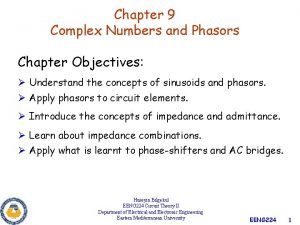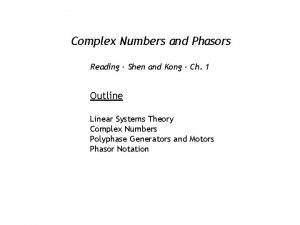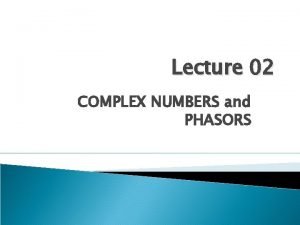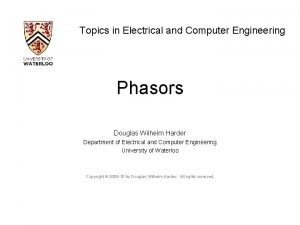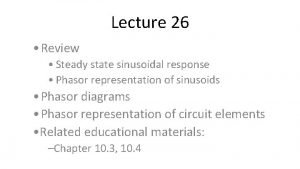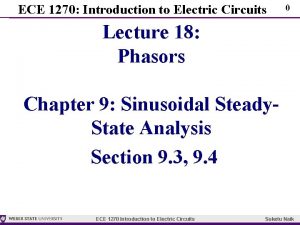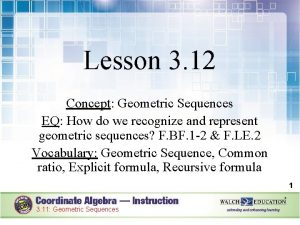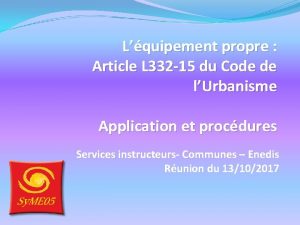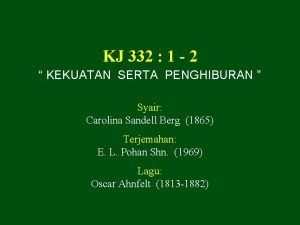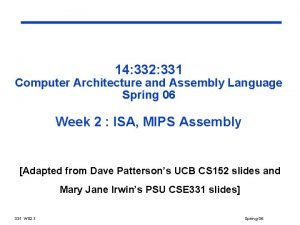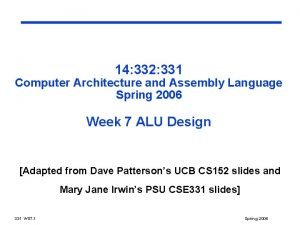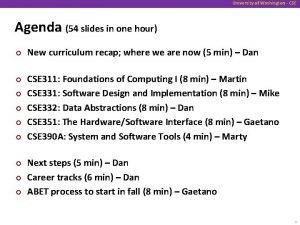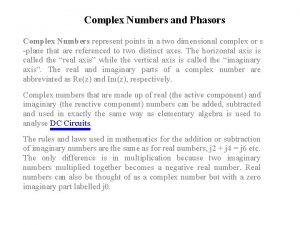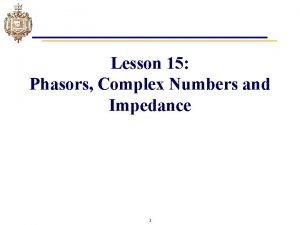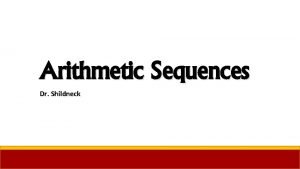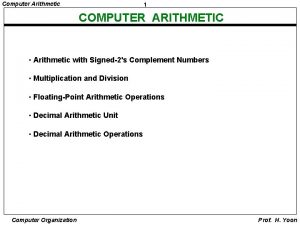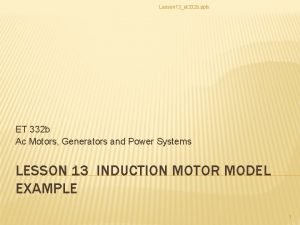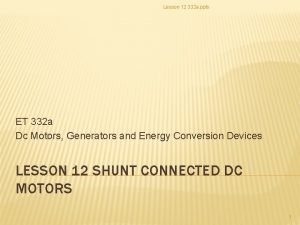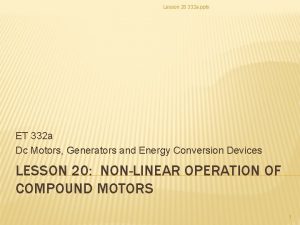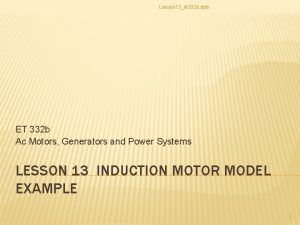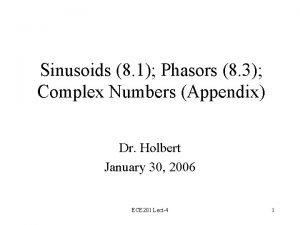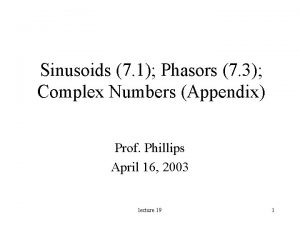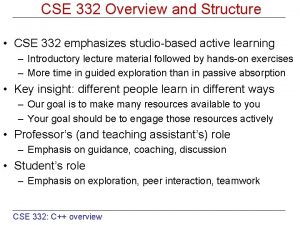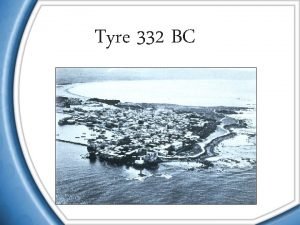Lesson 1 Phasors and Complex Arithmetic ET 332




















- Slides: 20

Lesson 1: Phasors and Complex Arithmetic ET 332 b Ac Motors, Generators and Power Systems lesson 1_et 332 b. pptx 1

Learning Objectives After this presentation you will be able to: Ø Ø Write time equations that represent sinusoidal voltages and currents found in power systems. Explain the difference between peak and RMS electrical quantities. Write phasor representations of sinusoidal time equations. Perform calculations using both polar and rectangular forms of complex numbers. lesson 1_et 332 b. pptx 2

Ac Analysis Techniques Time function representation of ac signals Time functions give representation of sign instantaneous values Voltage drops Source voltages Currents Where Vmax = maximum ( peak) value of voltage Emax = maximum (peak) value of source voltage Imax = maximum (peak) value of current qv, qe, qi = phase shift of voltage or current w = frequency in rad/sec Note: w=2 pf lesson 1_et 332 b. pptx 3

Ac Signal Representations Ac power system calculations use effective values of time waveforms (RMS values) Therefore: So RMS quantities can be expressed as: lesson 1_et 332 b. pptx 4

Ac Signal Representations Ac power systems calculations use phasors to represent time functions Phasor use complex numbers to represent the important information from the time functions (magnitude and phase angle) in vector form. Phasor Notation Where: VRMS, IRMS = RMS magnitude of voltages and currents q= phase shift in degrees for voltages and currents lesson 1_et 332 b. pptx 5

Ac Signal Representations Time to phasor conversion examples, Note all signal must be the same frequency Find RMS magnitude Time function-voltage Phasor Time function-current Find RMS magnitude Phasor Phase shift can be given in either radians or degrees. To convert, this conversion: use 1 degree = p/180 radians. lesson 1_et 332 b. pptx 6

Complex Number Representations Polar to rectangular conversion Rectangular form of complex number +j r -real q -j R-P conversion +real To convert between polar form and rectangular form, use calculator P-R and R -P keys or remember concepts from trigonometry P-R conversion Magnitude: Phase Angle: lesson 1_et 332 b. pptx 7

Complex Number Representations Example 1 -1 Rectangular-to-polar (R-P) conversion using trigonometry. Find the polar equivalent of the complex number z. Solution Magnitude Phase angle Watch for the location of the phasor when making P-R or R-P conversions. Some calculators return tan-1 into 1 st and 4 th quadrants only. lesson 1_et 332 b. pptx 8

Rectangular-to-Polar Conversion Check the angle given from R-P conversion by geometric interpretation. If real and imaginary parts both negative, angle is in Quadrant III Example 1 -2: Find the polar form of z=-4+j 5 Find r Compute phase angle This tan-1 function computes the angle in Quadrant IV. The actual angle is 180 degrees from this value ( - real, + imaginary is Quadrantlesson 1_et 332 b. pptx II) 9

Polar-to-Rectangular Using Trig Functions Conversion Equation Example 1 -3: Convert to rectangular form Ans lesson 1_et 332 b. pptx 10

Complex Number Arithmetic Properties of the imaginary operator j=√-1 +j The operator j translates physically into a 90 o phase shift j = 90 o. . . a 90 degree phase lead -j = -90 o. . . a 90 degree phase lag 90˚ lead -j Also 1/j = -j and 1/-j = j j (-j) = 1 90˚ lag lesson 1_et 332 b. pptx 11

Complex Number Arithmetic Complex Conjugate-reflection about the real axis Conjugate (rectangular form) +j z b Change sign on imaginary part Conjugate (polar form) q -q -b z* Change sign on angle -j lesson 1_et 332 b. pptx 12

Complex Number Arithmetic Addition and Subtraction of Complex Numbers For calculators without complex number arithmetic 1) convert both numbers to rectangular form 2) add/subtract real parts of both numbers and imaginary parts of both numbers Multiplication and Division of Complex Numbers For calculators without complex number arithmetic 1) convert both numbers to polar form 2) multiply/divide magnitudes 3) add angles for multiplication, subtract angles for division Inverting a Complex Number 1) convert number to polar form z q 2) perform division (1 0 o) / (z q) = 1/z -q lesson 1_et 332 b. pptx 13

Complex Number Arithmetic Example 1 -4: Given the sinusoidal time functions and complex numbers below: Find V 2+V 1, V 2 -V 1, V 1/Z, I(Z) give the results in polar form for all calculations lesson 1_et 332 b. pptx 14

Example 1 -4 Solution (1) Convert v 1(t) and v 2(t) into phasors Find magnitudes Find V 1+V 2 Convert phasors to rectangular form lesson 1_et 332 b. pptx 15

Example 1 -4 Solution (2) Add real and imaginary parts Convert to polar form Ans lesson 1_et 332 b. pptx 16

Example 1 -4 Solution (3) Find V 1 -V 2 subtract real and imaginary parts Convert to polar form Ans lesson 1_et 332 b. pptx 17

Example 1 -4 Solution (4) Compute the quantity V 1/Z and give the results in polar form Convert Z to polar form To compute the quotient, divide magnitudes and subtract phase angles Ans lesson 1_et 332 b. pptx 18

Example 1 -4 Solution (5) Compute the quantity I(Z) and give the results in polar form Convert I to polar form Multiply magnitudes and add phase angles to get result Ans lesson 1_et 332 b. pptx 19

ET 332 b Ac Motors, Generators and Power Systems END LESSON 1: PHASORS AND COMPLEX ARITHMETIC lesson 1_et 332 b. pptx 20
 Adding phasors
Adding phasors Phasor notation
Phasor notation Addition and subtraction of phasors
Addition and subtraction of phasors Vrms to vpp
Vrms to vpp Phasors electrical engineering
Phasors electrical engineering Steady state sinusoidal analysis using phasors
Steady state sinusoidal analysis using phasors Phasor notation
Phasor notation Simple compound complex and compound-complex sentences quiz
Simple compound complex and compound-complex sentences quiz Ghon complex and ranke complex
Ghon complex and ranke complex Simple compound complex rules
Simple compound complex rules Electra complex vs oedipus complex
Electra complex vs oedipus complex Psychodynamic personality theory
Psychodynamic personality theory Sublimation defence mechanism
Sublimation defence mechanism Lesson 3: arithmetic and geometric sequences
Lesson 3: arithmetic and geometric sequences L332-15
L332-15 Kj 445
Kj 445 14:332:376
14:332:376 14:332:331
14:332:331 14:332:331
14:332:331 Cse 332 p3
Cse 332 p3 Cse 332 uw
Cse 332 uw
